#RStudio assignment help
Explore tagged Tumblr posts
Text
Why Waste Time on R Studio Errors When You Could Be Getting Top Grades with Expert Help
Struggling with R Studio assignments? You’re not alone. From confusing error messages to complex statistical models, R Studio can quickly become a time-consuming maze—especially when you’re under pressure to deliver top grades. Whether you’re a data science student, business analyst in training, or just beginning your programming journey, chances are you’ve lost hours trying to fix code that just won’t work. That’s where RStudio Assignment Help becomes a game-changer. Instead of wasting valuable study time on trial and error, expert guidance can help you learn faster, solve problems more efficiently, and consistently perform better in your coursework. In this article, we’ll explore why students struggle with R Studio, the hidden cost of going it alone, and how personalized support can turn those struggles into academic success.

The R Studio Struggle Is Real
1. R Studio Isn’t Beginner-Friendly
R Studio is widely used in academia and the professional world, but it's not exactly built for newcomers. It assumes you understand core programming logic and statistical concepts—something not all students have when they’re just starting out.
A simple task like importing a dataset can spiral into hours of error handling if you're unfamiliar with formats, file paths, or data types.
Example: A student trying to read a CSV might get the dreaded "Error in file(file, 'rt')" message—not because the file is broken, but because the working directory is wrong. That one issue can cost you an entire evening.
2. Errors Are Vague and Time-Consuming
R errors often don’t point you directly to the root cause. You might get “subscript out of bounds” or “object not found,” and be left to decode what went wrong, line by line.
By the time you figure it out, you’ve:
Lost hours of productivity.
Fallen behind on other assignments.
Grown more frustrated than informed.
3. Learning Alone Slows Progress
While self-teaching is admirable, doing everything on your own is inefficient—especially when assignment deadlines are looming. Watching videos, reading manuals, and scrolling through forums might eventually solve your problem, but it’s often at the expense of deeper learning and better results.
Why Grades Suffer Without the Right Help
When you spend more time fixing code than understanding it, your grades inevitably take a hit. Here's why:
1. You’re Focused on Fixing, Not Learning
Most students don’t stop to ask why the code works—they just want it to work. This results in superficial understanding, where concepts aren’t truly absorbed, and you can’t apply them in exams or future projects.
Real-world insight: If you can’t explain your code, you probably don’t fully understand it—and that shows up in graded assessments.
2. Incomplete Assignments = Lower Scores
R Studio errors often lead students to submit incomplete or incorrect work just to meet deadlines. This is especially true when visualizations don’t render or statistical outputs are misinterpreted.
Even a half-done assignment can tank your GPA.
3. Stress Affects Performance
The mental drain from hours of trial-and-error takes a toll. When you’re stressed, tired, and pressed for time, your ability to write clean, thoughtful code and explain your results clearly goes out the window.
How Expert Help Changes the Game
Getting help isn’t about cheating—it’s about learning more efficiently and performing better. Here’s how expert assistance transforms the R Studio experience:
1. Understand Problems Instead of Guessing
Instead of pasting code into a search bar and hoping for a Stack Overflow miracle, expert help gives you contextual explanations. You don’t just learn the fix—you learn why it works.
Example: A student trying to calculate summary statistics with dplyr learns how group_by() and summarise() interact, avoiding future errors and improving their data-wrangling skills.
2. Learn Best Practices from Day One
Experts don’t just solve your current problem—they show you how to write better code going forward. You’ll learn things like:
Writing reusable functions.
Cleaning messy data efficiently.
Creating well-labeled, publication-ready graphs.
This builds skills that carry over into future assignments and even internships or job roles.
3. Save Time and Boost Productivity
With the right help, a task that takes you five hours on your own can be done—and understood—in one. That’s four hours you can spend improving your report, studying for another class, or simply getting some rest.
Real-Life Example: From Frustration to A+
Meet David, a business analytics student who was assigned a customer segmentation project using R Studio. He had decent grades, but hit a wall when asked to perform K-means clustering and interpret the results.
After two days of trial and error, he turned to expert guidance.
The result?
He understood the logic behind clustering.
He learned to visualize clusters with ggplot2.
He submitted a complete, error-free assignment—and scored an A.
More importantly, he felt confident applying the technique in his final project, boosting both his grade and his resume.
Topics Where Expert Help Makes the Biggest Impact
1. Data Wrangling with dplyr and tidyr
Understanding joins, reshaping data, and working with missing values are all easier with guidance.
2. Data Visualization with ggplot2
From scatter plots to histograms, expert help can show you how to use aesthetics, layers, and themes like a pro.
3. Statistical Modeling
Regression, classification, time series—learn how to build, evaluate, and explain models without second-guessing your results.
4. R Markdown and Reporting
Integrating analysis and written explanation is key to academic success. Expert help ensures your reports are polished and professional.
Common Myths About Getting Help—Debunked
“If I get help, I’m not learning.” Actually, you’re learning faster and smarter. It’s like having a tutor who explains why something works, not just how to do it.
“It’s only for struggling students.” Even top-performing students use help to maintain their edge and save time.
“I should figure it out myself.” That’s noble—but in a time-pressured environment like college, efficient learning is more valuable than pride-driven problem-solving.
Conclusion: Stop Struggling, Start Succeeding
R Studio is a skill, and like any skill, it’s best learned with support. Struggling through errors, wasting hours on bug fixes, and submitting half-done assignments doesn’t make you a better student—it just makes you an exhausted one.
Expert help isn’t about shortcuts. It’s about understanding faster, working smarter, and getting the grades you deserve—without sacrificing your sanity.
Action Step: Reclaim Your Time and Focus
Think about the last R Studio error that derailed your workflow. Instead of battling it alone next time, take this smarter approach:
✅ List the issue. ✅ Seek help to understand the solution. ✅ Apply it to your code—and future assignments.
Don’t waste another semester buried in syntax issues. Use the tools and help available to you, and make your time in R Studio count toward success, not stress.
1 note
·
View note
Text

Explore 8 essential vizualization plots and graphs you can make in Rstudio. Engage with our Rstudio Assignment Help experts to create stunning and insightful visualizations.
0 notes
Text
Excel in your machine learning projects with expert guidance. Explore our comprehensive machine learning project help services at DataScienceAssignment.com to achieve success.
#statistics assignment help#nlp project help#machine learning project help#Homework help for Tableau and PowerBI#SPSS assignment help#RStudio assignment help
0 notes
Text
Checkout my bio
#study #math #statistics #pythonprogramming #microsoftexcel #msexcel #Rstudio #spss #STATA #matlab #mathlab

#maths#mathskills#statistics#rstudio#stata#spss assignment help#matlab#ms excel#microsoft excel#pythonprogramming#pythonprojects
0 notes
Text
Complete Guide to R: Wrangling, Visualizing, and Modeling Data Course
3/24/25
I found this course interesting! it's super in depth, and obviously very well put together. I do honestly wished we had started our R work through this - as the visuals talking through the steps really helped me understand a lot of the R work easily, especially as it comes to ggplot and what i'm supposed to be getting out of it. Nothing against the text descriptions of assignments you had created for us to learn R in the syllabus, but I do think these videos are super helpful, and would've made the process a lot easier to get into. I know especially those that had much less coding experience in your classes this semester had to get over a bit of a learning curve when it came to using an IDE environment like RStudio, and I think the videos would've been great in that aspect. Additionally, having done some data science work myself in the past, I liked seeing the video about R in context, and I hadn't heard of some other applications (like Julia, or Rapidminer) so it was interested getting to do a bit of a deep dive into those as well. Especially now that we have had some exposure to R through the homework on your syllabus, I think this course is less helpful to us now, but structuring the course homework by taking advantage of the videos on this site in the future I think could be very useful.
0 notes
Text
Conducting Bivariate Analysis Using a mtcars Dataset in R Studio
Know how to carry out bivariate analysis using a mtcars dataset in Rstudio. Get instant R Studio assignment help to perform advanced bivariate and regression analysis.
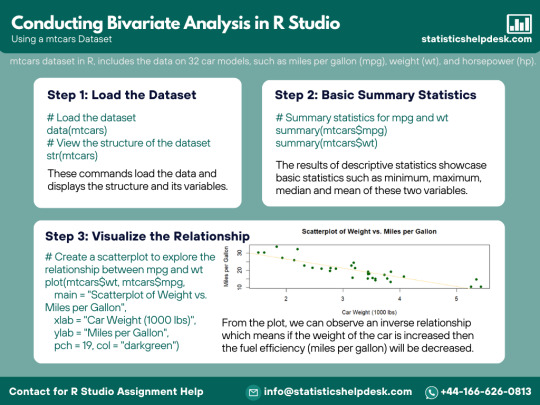
0 notes
Text
SUMMA CUM LAUDE? #22
I've done it again.
August 21, 2024. Second Semester and 300 Level both ended on the 9th of August, but this is my first post for the semester. An extremely eventful semester with a not so fairytale ending.
This semester, I wanted to be everywhere, in and out of school. Force myself to manage my time and juggle this and that. Expand a bit. I got off to a great start, getting things done here and there. Weddings, meetings, classes, assignments, service, it was going well. You're expecting to find out where it went wrong right? Well, sorry because even I don't know. Conclude however you like based on what I tell you.
12 Courses. 3 Units (1), 2 Units (9) and 1 Unit (2). 23 Units in total. The goal remained the same: get as many As as possible (which means get all As). We were warned about this semester, a semester with one stumbling block here and there but the only one I was initially really worried about was EEG325 - Digital Design of Logic Systems. Why? The lecturer was known for failing students and giving lots of Cs and Ds and Es and Fs. His reason was ridiculous when he said it in class, although he did something somewhat surprising during our exam. I won't judge until I see results, but his ways are nonsensical, let it be known.
2nd Semester, filled with a slow and steady build up to an explosive disaster.
My Laptop and Computer Village
I don't recall talking about the pain that is my laptop but I am certain I must have mentioned it prior to this moment. Slow and frustrating. After my screen decided to give up on me at the climax of last semester I got it repaired at a friend's dad's shop at Computer Village. 65K. Fine.
Early in the semester, Dr Ogboi came in for Software Development Techniques and Machine Learning (SDT & ML, two courses this semester). Told us we would need Visual Studio for C++, SQL, Java and Eclipse, PyCharm, MATLAB and R and RStudio. You can imagine what was going through my head, was I about to dive into suffering throughout the semester with the HDD in my laptop. The time had finally come to upgrade right? HDD to SSD, increase the RAM and all would be well.

The explosion began to build up that day, but I did not know. Got the SSD on a Friday the 10th of May 2024. That same day, I got to my house and my laptop started beeping. It told me to replace the hard drive because it was faulty. My brother followed me to Computer Village to following day. It rained, I don't want to tell this story, but we suffered that day and eventually got them to replace the SSD with another one that was working (so I thought). As we progress, I will fill you in on what this laptop did to me all semester.
April and May were just little outings here and there. Birthday, wedding, all of that. June was when the real activity began, but you can't attend everything, so I chose the ones to participate in: Youth Week, Fathers' Day and ULES Sports Festival. I left out ULES Faculty Week and Sodeinde Hall Week to make sure I was still getting academic work done.
Due to my failure to update during the semester, the timeline is foggy and I wasn't exactly recording these things as they happened so I'll just try my best.
Youth Week and ULES Sports Festival
I wanted to be present in both of these events. And they did not just happen in one day, so I had to be present at church before that week and also be present at training at training. Usually during the weekends. So in the earlier parts of the semester, a lot of my weekends were usually spent at home or a slice at sports centre. If I attended training, I would still study but if I went home something always happened that prevented my studying.
Till now, I don't know 100% but I am sure enough that the SSD I got is faulty. My Laptop crashed and crashed and crashed... I spent so much time reading up community help for Microsoft and Dell because of this issue. I would go home for one church program and be unable to study because every crash meant I had to reinstall windows or reset my PC, which always led to a loss of my apps or my files and so I would spend the entire weekend re-downloading my Windows and Apps so I would have them for the following week in school. This happened over and over again. What apps by the way? The ones Dr Ogboi had me download for his courses. Guys this was throughout the semester, I'm on holiday now and I am not free from it yet.
It seems funny because you would think once I found of the cause I would be able to avoid it, but this thing came in different shapes and sizes. It seemed like file transfer issue, battery issues, RAM issues, it just kept on crashing in diverse ways and so I could never place my finger on the actual problem which is why I believe it's the SSD. I informed the Computer Village guy, but I did not want to keep on going there, it was obvious these guys were dealing defective goods. After some time, the response was "Ha", WHAT?!
So for the youth week and sports festival, I could not do much studying to be honest. This was week one in June. And by the way, SEES absolutely dominated the ULES Sports Festival, and our kit was so beautiful, I had to buy it.

Father's Day
This was June 16 this year. I had been going home during the weekends prior to this one for preparations with the Royal Ambassadors. I was commanding the parade for this occasion. This weekend my laptop also crashed, which meant I couldn't do much studying or any at all because of the reinstallation. I should also mention that the reinstallation required quite an amount of data because some of the apps had to be downloaded from scratch all the time. Father's Day went well and because exams were just a month away with no sign of any postponement, I told my friend that was the last bit of activity outside of exams for me because I had a lot of covering to do so I wouldn't get caught lacking during the exams.
Everybody do "hmmm"
July 1, 2024 10:55PM
Just two weeks after Father's day, my last side quest for the semester, I did something:

WHAT?!?!?! When did I become a politician? Elections????? How did this happen? I opened our student portal just before the deadline for the election applications and applied to be the Vice President of SEES. #Kunle4VP. Why did I do this? I felt it would be a good experience and this was also part of my getting more involved in school activities. I didn't have long term plans for this, but I needed to step out of my comfort zone. I had been contributing here and there in the department, so I believed it was time to do even more. Honestly you could say I was just being an agent of chaos and be correct because someone was already vying for that role even from my class but I did not care at that point. I wanted to be VP. Big mistake ladies and gentlemen. I 100% should have stayed away from the portal that night.
The election period was basically two weeks. The first week I had a project to complete on Monday and I had tests every other day of the week. Week 1 was basically trying to get support from various levels and put plans and the campaign together so I could go all out in Week 2. Isn't this crazy? I had no plans and had to cook up a lot of stuff in such short amount of time. I knew I was running from a losing position, but I wanted to try anyways. I've been saying "I" so much but it's about me so haha. I did election stuff and I also did studying because how else would I pass my tests? Two of those tests I didn't cover everything I was supposed to cover and I lost huge amounts of marks in both because I couldn't attempt them at all. I was now fully in a remontada mode even before concluding all tests prior to the exams. Weekend of Week 1, instead of studying after volleyball practice, what did I do? I went to ISL to watch Year 1 and Year 2 SEES play football matches because I was trying to get support for the elections. How crazy is that?! I was now a real politician because what on earth was I doing there. I thought I was done with extra curriculars but see me for goodness sake. Unbelievable stuff. Week 2 of the elections was nothing short of an academic lack of focus. Fine, the election held on that Friday (and then Saturday, it got re-done because Unilag servers were too poor) and so I needed to go all out. Going all out meant wrapping up the campaigns, manifesto hearings and putting plans in place for the election day. This meant spending ridiculous amounts of time on election stuff and little time on preparing for my exams. Are we seeing this? Yes. Was I doing something that should be encouraged? Absolutely but you can do the right thing but at the wrong time or you just go about it in the wrong way. This was really close to exams, so a rapid-fire approach wasn't really proper to be honest.
For the record, I had really good plans because my team really believed in me and I in them and I looked forward to implementing those plans. I lost the elections. Later, maybe in the next post. I will do some reflection on how I really felt about these two weeks after my exams. It was now time to face exams once and for all abi, hehe nope. One more activity.
ARB Quiz Grand Finale
Yeah remember the ARB Quiz from First Semester, the Grand Finale happened on the day of the rerun of the election. Are you whining Vice Presidential Candidate???
It was on a Saturday. The hall was empty but that didn't stop us. Hearing from the ARB guys that day, I knew I had to be part of them from next session. I love this vision. So the Quiz, we had to replace one of our fresher starboys with someone from 2000 Level. The quiz was really bad for us (Computer Engineering). Everything went well in the preliminaries, but the final was a disaster. Electrical & Electronics Engineering was on fire by the way, they were unbelievable. So it's the final round (General Knowledge). Chai, I just tried to recall the exact comeback we made but I can't remember, this hurts. Oh well, we were dead last going into the final round. Electrical & Electronics had already won. It was Metallurgical and Materials, System, Chemical and Computer fighting for 2nd and 3rd. You could exclude us and be right because we needed to get all questions right and hope others failed theirs in order to finish in a position. We managed to do just that. Thank God, we left there with something.

Finally, it was just me and my exams. Reality hit me like nothing else. I'll conclude the semester in #23. Byeeeeee.

0 notes
Text
SPSS vs Excel: Which Is Better for Bivariate Data Analysis Homework?
In today's data-driven world, data analysis is crucial for decision-making across various fields like economics, finance, and healthcare. With the rising demand for data research, finding patterns in data and making business decisions, software tools are being developed or upgraded to suit the needs. Some of the software often used for data analysis include the Statistical Package for Social Sciences (SPSS) and excel. Some other frequently used software include SAS, STATA and RStudio. These software commonly used in academics as well as industries provide a robust platform and functionalities for conducting advanced analytics. Mastering these tools requires solid grasp of knowledge in statistical concepts and software skills. Students often get confused whether to use SPSS or Excel for conducting bivariate analysis. We will do a comparative analysis to address this issue.
Data analysis involves use of statistical software tools to study complex data and derive valuable insights for informed decision making. To master data analytics, it requires hard work and consistent practice on such software. Learning the various visualization tools to demonstrate the pattern of data and its interpretation poses a challenge for many students. This is where data analysis assignment help can be a perfect solution for students struggling with finding insights.

Understanding Bivariate Data Analysis
Before we discuss the appropriate software to be used, let us understand biovariate analysis first. Bivariate data analysis is used when examining the relationship of one variable with another, which is important in economics and econometric studies. It assists in establishing relations like between income and expenditure or between price and demand. Some of the common statistical techniques applied in bivariate analysis are correlation, regression, chi-square, t-test as they help in discovering the patterns, hypothesis and conclusions. Knowledge about these techniques is mandatory for economics students and therefore the choice of right software for the analysis is of paramount importance.
SPSS: The Statistical Powerhouse
One of the widely-used software tool is the SPSS (Statistical Package for Social Sciences) that is designed by IBM is an analytical tool popular among data scientists and professionals for its complex data handling. One of the great features of SPSS is the fact that even an inexperienced programmer can easily perform the most complex analyses of the data. Correlation, regression analysis, chi-square tests and other statistical tests can be performed in SPSS with just a few clicks without writing any syntax. These features help users perform complex calculations on data conveniently and present the findings in a format that is easy to comprehend, thus proving to be very beneficial to student and researchers.
Advantages of SPSS for Bivariate Data Analysis:
Comprehensive Statistical Capabilities: It has a wide range of statistical functions best suited for conducting bivariate analysis such as correlation, regression, t-tests, chi-square tests and so on.
User-Friendly Interface: The interface of SPSS is user friendly and one does not need to be a statistic expert to be able to perform statistical operations. This feature is very useful to most of the students especially those who perhaps do not have any programming experience.
Advanced Data Visualization: SPSS gives the user several choices for data visualizations including scatter plots, histograms and box and whisker plots. These are very important when it comes to finding patterns and insights out of the results of bivariate analysis and in presentation of findings.
Case Studies and Real-World Applications: SPSS is popular among academics, and various case studies and research papers emphasize the software’s efficiency in bivariate data analysis. For instance, a recent research based on finding correlation between the economic development and environmental pollution used SPSS to conduct regression analysis.
Excel: The All-Rounder
Microsoft Excel is arguably the most popular and famous software that is used in the data analysis process. Excel is commonly regarded as a program used for basic data input and manipulation but it is also useful for analysis of bivariate data.
Excel's flexibility and accessibility make it a popular choice among students as well as professionals. It is widely available, cheap, easy to learn, and capable of performing a variety of statistical analyses. Although it lacks some advanced statistical functions compared to the SPSS, it is still a very flexible and easy tool for quick learning.
Advantages of Excel for Bivariate Data Analysis:
Widespread Availability and Familiarity: Excel is one of the applications developed by Microsoft as part of the Microsoft Office package that is used in academic institutions as well as in the business world. Excel is the program that most students are already acquainted with making a primary choice for basic data analysis.
Basic Statistical Functions: Standard software tools like Excel contain numerous statistical functions that might be used for bivariate analysis, such as correlation analysis and regression analysis. Although all these functions, may not be as elaborate as in the SPSS but are nonetheless adequate for most bivariate data analysis.
Customization and Flexibility: One of the significant features of excel is the customization. Users can create custom formulas, pivot tables, plots and customize how the results are presented.
Illustrative Example: Suppose a student in economics undertakes research to establish the correlation between GDP and unemployment rates in various states. Excel has a Data Analysis Toolpak which one can use to do regression analysis and the chart section can be used to plot scatter diagrams and regression line in order to understand the outcome more easily.
Comparative Analysis: SPSS vs. Excel
When it comes to bivariate data analysis, both SPSS and Excel have their strengths and limitations. The choice between the two ultimately depends on the specific requirements of the analysis, the user's familiarity with the software, and the complexity of the data.
Statistical Depth: SPSS clearly outshines Excel in terms of statistical depth. It also provides a more extensive selection of statistical tests and additional data analysis tools and features. For all the students who need to work with more advanced forms of the bivariate analysis such as the multivariate regression or chi-square, SPSS is preferred.
Ease of Use: In comparison, Excel is much easier to master than SPSS, as it is relatively easier to learn. For simple bi-variate analysis Excel has a better interface than SPSS.
Data Visualization: Data Visualization capabilities of both platforms are quite informative. However, in SPSS, more options are available especially for plotting statistical graphics that are immensely helpful to identify the results and insights.
Cost and Accessibility: Excel is bundled as part of the Microsoft office suite and it is easier to acquire and usually cheaper for students. SPSS on the other hand, may need regular update and monthly subscription that may restrict students from using it.
Support and Resources: SPSS has a lot of study materials, tutorials and video lessons that can be highly useful for students at the time of using the software. Excel on the other hand too have a lot of material available, but material based on data analysis is a bit limited.
Recent Examples and Case Studies
To illustrate the practical applications of SPSS and Excel in bivariate data analysis, consider the following examples:
Example 1: SPSS in Research: A study published in the "Journal of Economic Studies" used SPSS to analyse the relationship between inflation and unemployment in developing countries. The researchers used SPSS to perform a bivariate regression analysis, which helped them identify a negative correlation between the two variables, supporting the Phillips curve theory.
Example 2: Excel in Coursework: An economics student at a university used Excel to analyse the relationship between consumer spending and income levels. Using Excel's regression analysis tool, the student was able to identify a positive correlation between the two variables, which was then used to support a hypothesis in their term paper.
Making the Right Choice: Excel or SPSS?
Each software has its own advantages and disadvantages. SPSS is particularly powerful since it has superior analytical capabilities to handle complex data and insightful visualization functionalities. Excel on the other hand is easier to use, cheap on the pocket and can support simple statistical operations like bivariate analysis. For economics students the decision will therefore depend on the depth of the analysis required, availability of this software and the individual preference. Both tools can take time to master, and demands consistent practice. With the rising academic pressure due to evolved modern day courses, students often seek data analysis homework help especially when dealing with assignments having strict deadlines and complex analysis.
Data Analysis Assignment Help: Your Path to Academic Success
It is often difficult for students to solve data analysis assignments on time as it requires thorough statistical concepts, software proficiency and analytical mindset. Our Data Analysis Assignment Help is a perfect service that helps students to solve their homework or assignments and complete them on time and with assured grades.
What Our Services Offer:
At Economicshelpdesk, we offer assistance with the most commonly used statistical software packages such as SPSS, Excel, SAS, Eviews, JMP, Stata, Jamovi, Python, RStudio, Minitab and many others. No matter if you are dealing with bivariate analysis, or regression models, hypothesis testing or any other statistical computing even, our team of professional data analysts are here to help.
When you avail our services, you receive:
Comprehensive Reports: Our solutions consist of comprehensive reports containing detailed explanation, interpretation, plots, tables, and outputs. Each report is prepared in a simplified manner that acts as a self-explanatory guide for every student. Detailed Explanations: We give detailed explanations of the method, the interpretation of the results and a logical conclusion for accurate analysis. References and Citations: Our reports are properly referenced to ensure that they meet the acceptable academic standards.
How to Avail Our Services:
The process is simple and student-friendly:
Submit Your Assignment: Provide us with the details of your data analysis homework, including any specific instructions or datasets via email [email protected] or upload it through your registered account.
Receive a Quote: Upon reviewing your assignment, we assess the level of difficulty and deadline to quote a price.
Get Your Solution: Upon the confirmation of your order, our experts get down to work on your assignment and complete it before the agreed deadline.
Our Data Analysis Assignment Help goes beyond mere assistance; it is a pathway to academic excellence. With expert guidance, you can navigate the complexities of data analysis and achieve outstanding results in your studies.
Helpful Resources and Textbooks
For students looking to deepen their understanding of bivariate data analysis using SPSS and Excel, the following resources and textbooks are highly recommended:
"Discovering Statistics Using IBM SPSS Statistics" by Andy Field
"Statistics for Managers Using Microsoft Excel" by David M. Levine, David F. Stephan, and Kathryn A. Szabat
0 notes
Text

📊 Got RStudio assignments piling up? Don't sweat it! Our team of experienced data analysts is just a message away. Say goodbye to assignment stress and hello to top grades. Get in touch now for RStudio Assignment Help!
0 notes
Text
How to Choose the Best Data Analytics Course for Your Career Growth

Data analytics has become one of the most sought-after skills in today’s job market. Whether you want to boost your career, switch fields, or simply learn how to make sense of data, choosing the right data analytics course is key. But with so many options available online and offline, it can feel overwhelming to decide which course fits your needs best.
In this guide, I’ll walk you through how to select the best data analytics course based on your current experience, learning style, and career goals. I’ll also share some top-rated courses you can trust, along with practical advice on what to look for before enrolling.
Why Data Analytics Skills Matter Today
Before diving into course options, it’s important to understand why data analytics skills are in such high demand. Businesses of all sizes rely on data to make smarter decisions — from improving marketing strategies to optimizing operations and predicting customer behavior.
By mastering data analytics, you become someone who can translate raw numbers into clear insights. This ability opens doors to roles like data analyst, business analyst, data scientist, and more. Even outside traditional data roles, understanding analytics gives you a competitive edge in many industries.
Factors to Consider When Choosing a Data Analytics Course
Choosing the right course isn’t just about picking the most popular program. It’s about finding a course that matches your current skill level, preferred learning method, and career goals. Here are some key points to keep in mind:
First, assess your current experience with data. Are you a complete beginner with little to no technical background? Or do you have some programming or statistics knowledge? This will help you avoid courses that are either too basic or too advanced.
Second, think about how you learn best. Do you prefer self-paced online videos where you can go at your own speed? Or would you benefit more from live classes with interaction and instructor support? Some learners thrive in bootcamps or workshops that focus on hands-on projects.
Third, clarify your goals. Are you aiming to land an entry-level job in data analysis? Or do you want to specialize in areas like predictive analytics or data visualization? Some courses are broad, covering many topics, while others focus deeply on specific skills.
Top Data Analytics Courses to Consider in 2025
Now that you know what to consider, here are some of the best data analytics courses and programs available today, each catering to different learners and goals:
1. Coursera’s Data Science Specialization by Johns Hopkins University This comprehensive program is perfect for beginners and intermediate learners. It covers fundamental data analysis, statistical concepts, and tools like R and RStudio. The specialization is well-structured, offering both theoretical knowledge and practical assignments.
2. edX Data Science MicroMasters Offered by several leading universities, this program is ideal if you want a strong foundation in data science and analytics. It covers key areas like machine learning, data visualization, and statistical analysis. The MicroMasters can also count towards a full master’s degree if you want to advance academically.
3. Udacity’s Data Analyst Nanodegree This course emphasizes practical skills using Python and SQL — two of the most popular tools in data analytics. It’s well-suited for learners who want hands-on projects and real-world applications, such as data cleaning, statistical analysis, and visualization.
More Options to Explore
4. Harvard University’s Data Science Certificate (via edX) If you’re looking for a rigorous academic program, Harvard’s certificate covers R programming, exploratory data analysis, and statistical modeling. It’s a solid choice for those who want a deeper understanding of analytics with a strong emphasis on theory.
5. IBM Data Analyst Professional Certificate on Coursera Designed for beginners, this program walks you through Python, SQL, and Jupyter notebooks, along with hands-on projects that build job-ready skills. It’s highly practical and industry-recognized, often praised for its clear, step-by-step approach.
6. UCI’s Predictive Analytics Certificate For those interested in specializing, this certificate focuses on predictive modeling, data cleaning, and visualization techniques. It’s a great pick if you want to work in forecasting, risk management, or other specialized analytics roles.
7. General Assembly’s Data Analytics Course Known for its bootcamp-style training, General Assembly offers both full-time and part-time programs. Their courses emphasize real-world projects and teamwork, helping you build a portfolio that impresses employers.
8. DataCamp This platform is perfect for flexible, self-paced learners. DataCamp offers dozens of courses in R, Python, and SQL, allowing you to customize your learning path and focus on specific skills like data visualization or statistical modeling.
Practical Tips to Maximize Your Learning
Choosing the course is only the first step. To really benefit from data analytics training, keep these tips in mind:
Practice consistently. Theory alone won’t help you become a skilled analyst. Work on exercises, projects, or real datasets to apply what you learn.
Join online communities. Platforms like LinkedIn, Reddit, or course-specific forums allow you to connect with peers and experts, ask questions, and stay motivated.
Build a portfolio. Showcase your skills with projects or case studies. This can be a game-changer when applying for jobs or freelance work.
Stay updated. The data analytics field evolves rapidly. Follow blogs, attend webinars, or take short refresher courses to keep your skills sharp.
Conclusion
The best data analytics course is one that fits your current skills, learning style, and career aspirations. Whether you prefer a structured academic program or a flexible online platform, there are excellent options available to help you gain real-world skills.
Ready to take the first step? Explore the courses mentioned here, read reviews, and choose the one that feels right for you. Your data-driven future awaits!
Common Questions About Data Analytics Courses
How long does it take to complete a data analytics course? It varies. Some programs are self-paced and can be completed in a few weeks, while others take several months. Choose a timeline that fits your schedule and goals without rushing.
Do I need programming skills before starting? Not necessarily. Many beginner courses start from scratch and teach programming basics as part of the curriculum. However, some intermediate or advanced courses expect prior knowledge of Python, R, or SQL.
Are online courses as valuable as in-person ones? Absolutely. Many top universities and companies now offer high-quality online courses with interactive content and real projects. What matters most is the course content and how you apply what you learn.
0 notes
Text

Comparison of RStudio and SPSS across seven key factors. Looking for comprehensive data analysis assignment help with R and SPSS? contact us today
0 notes
Text
Girl help I don't know how RStudio works enough for this assignment he barely teaches us this
3 notes
·
View notes
Text
so i'm 3 weeks-in my 5th year in this hell-hole called my university and
1) i've yelled about this already but, my physics prof is utterly incompetent and it is so fucking frustrating
2) my stats prof...is cramming so much review and is zooming through rstudio, a program i've used before but like...it's been a few months let's do some refreshers yeah? and like let's not give assignments students to do, all by themselves, t-tests and 1-way anova right off the bat perhaps yeah? it's their 1st time teaching the course and one student had a hard time setting the working directory...literally the most basic thing to do...so let's slown down yeah? oh and the "helpful" vids on canvas are half muffled so i can't hear shit and are honestly not that helpful, and also the internet (which was suggested to rely on if needed) is also unhelpful bc...if you don't know the basics well, these so-called helfpul forums will be a total foreign language and thus *unhelpful*
3) this other prof in my fisheries class has yet to answer my goddamn emails approving the genus i chose for an assignment and it needs to approved before i can start fucking writing it AND this prof is so fucking technologically impaired he either will forget to turn on his mic or share the screen on zoom (bc some students go on campus to attend lecture therefore it's like valid to forget these really fucking basic things) and if you try to ask a question at the end of class too bad bc he will shut the zoom session either after you asked the question or AS you're asking the question
3) i have yet to hear anything from my other prof with whom i'm doing *something* (supposedly called undergrad research) and it almost feels like he got me mixed up w another student?? which is like not great
4) i'm just really sick and tired of these so-called professionals leaving the students to basically teach themselves the material off the internet and paying-websites instead of like. doing their job. university professors are a fucking scam and i hate this country
#text#i fucking hate this school so much#dont go to penn state for a wildlife degree is all im gonna say
5 notes
·
View notes
Text
Assignment 5 Part 1
Assignment 5 has two parts. This first part is my interpretation of the assignment, the second part is a more true version of the assignment’s expectations.
Find the value of inverse of a matrix, determinant of a matrix by using the following values:
A=matrix(1:100, nrow=10) B=matrix(1:1000, nrow=10)
Assign letters to their respective matrix values:
>A <- matrix(1:100, nrow=10) >B <- matrix(1:1000, nrow=10)
First thoughts: looks like A will be 10 columns and 10 rows with values 1-100; and B will be 100 columns and 10 rows with values 1-1000. In my reading of matrices and their inversion I noted that a matrix must be a square to have an inverse, so I will not be finding the determinant or inverse of matrix B. Here is what matrix A looks like:
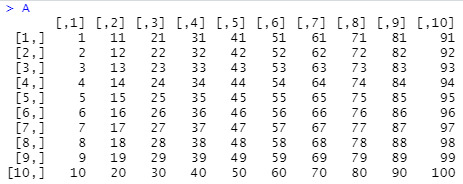
Looking at the “Inverse of a matrix” leaflet, I understand that to find the inverse the adjoint matrix and the determinant are needed.

The adjoint matrix is found by transposing the matrix and creating a matrix of minors and then cofactors. Luckily, R makes this easy to do. To transpose the matrix A, I can include byrow=T to assign the order of values by row instead of column:
Atran <- matrix(1:100, nrow=10, byrow=T)
Or simply use t() to transpose the matrix:
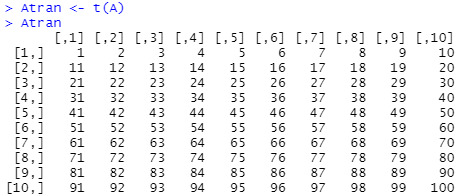
I installed the matlib package in RStudio to help with the matrix functions, especially to find the determinant of matrix A.

Turns out, matrix A (as it is 1:100) has a determinant of 0, which means its inverse cannot be calculated. So, instead of having an ordered matrix of 1:100, I want to randomize the values to execute the inverse of a matrix and the components related to it. I did this by using sample() and assigned the new matrix values to A2:
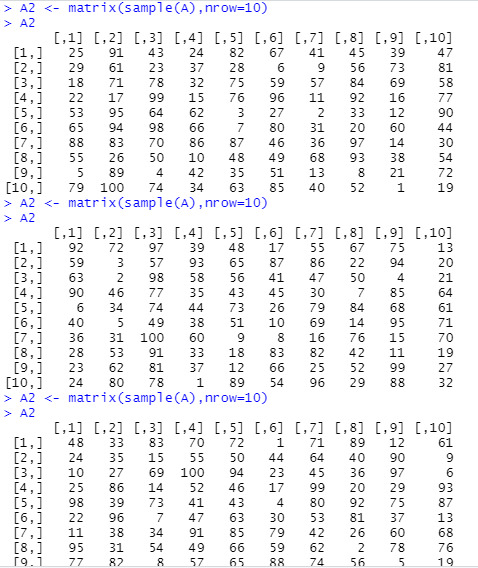
In the graphic above, I ran and printed matrix A2 three separate times to show that each time a different sample of values was made. I encountered this phenomena while experimenting with codes and wanted to show its effects on the data.
To secure a random sample, I assigned a matrix A3 to a set of A2 data values:
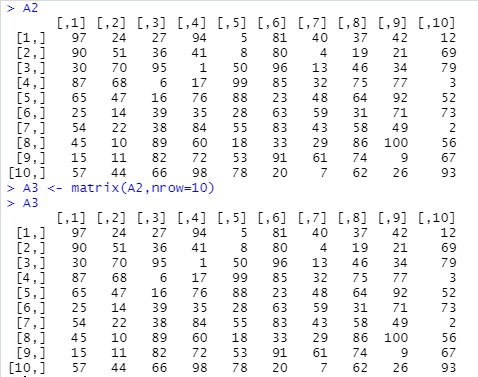
With the A3 matrix, I can find the determinate and inverse using det() and solve():
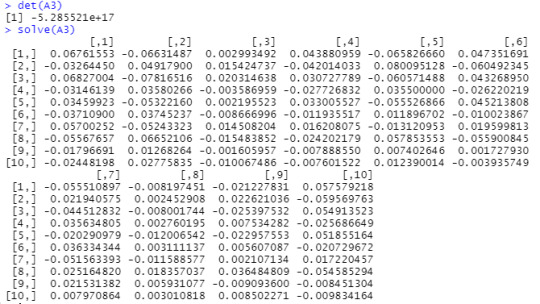
In the determinant value is an “e” and I didn’t know what that meant right away. An internet search has led me to understand -5.285521e+17 as -528,552,100,000,000,000. I think e more likely represents exponent over Euler’s number.
Other mathematical functions that can be applied to a matrix are rowMeans(), rowSums(), colMeans(), and colSums.
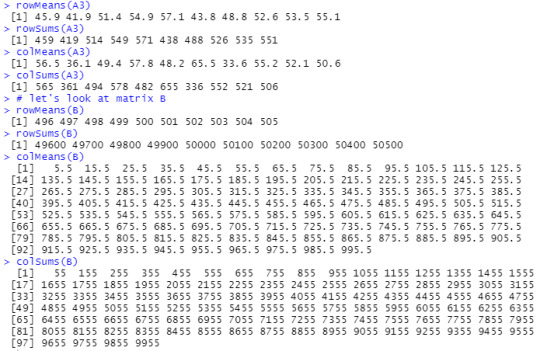
1 note
·
View note
Note
I don’t know R myself, but I know you can get ‘cheat sheet’ coding that’s supposed to make it easier at rstudio(.)com/resources/cheatsheets - hope that helps!
that does help so much!! :’)
like i said to the last anon - my prof actually gave us every code we needed for this assignment, but i completely missed it like an idiot which is why i’ve been dicking around with it for 5 hours when it could have taken 5 minutes. BUT as the assignments get more advanced, hopefully it’ll be a helpful thing that i trolled around R studio for basically forever lol. and i will definitely be using that cheat sheet. thank you, anon!!
4 notes
·
View notes
Text
What are the Resources for R Programming?
R programming is a powerful tool for data analysis and statistical computing. It is often used in fields such as finance, economics, and bioinformatics. If you are struggling with an R programming assignment, there are several resources available to help you.
Online tutorials and documentation: There are many websites that provide tutorials and documentation on R programming, such as the official R documentation website and the RStudio website.
Online communities: There are also many online communities, such as Stack Overflow, where you can ask questions and get r programming help from other R programmers.
Books and courses: There are many books and courses available that can help you learn R programming, such as "R for Data Science" by Hadley Wickham and Garrett Grolemund.
Hiring a Tutor: You can also hire a tutor who specializes in R programming to help you with your assignment.
Hiring an expert: If you want an expert to do the R programming assignment for you, there are several online platforms such as Upwork, Freelancer etc where you can hire an expert.
Consult with a colleague: you can also consult with a colleague who is proficient in R programming and get their help
By utilizing these resources, you can improve your understanding of R programming and successfully complete your assignment.

0 notes